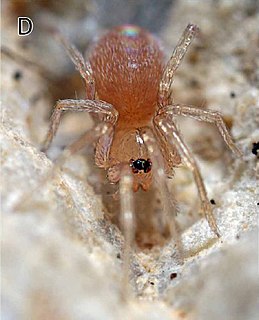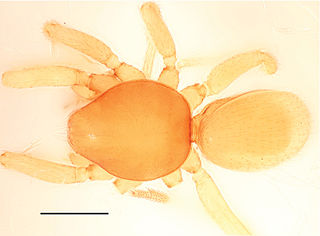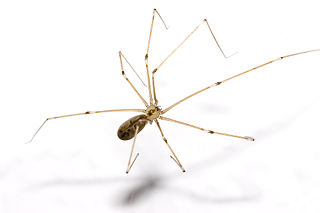
Oonopidae, also known as goblin spiders, is a family of spiders consisting of over 1,600 described species in about 113 genera worldwide, with total species diversity estimated at 2000 to 2500 species. The type genus of the family is OonopsKeyserling, 1835.

Crevice weaver spiders (Filistatidae) comprise cribellate spiders with features that have been regarded as "primitive" for araneomorph spiders. They are weavers of funnel or tube webs. The family contains 18 genera and more than 120 described species worldwide.

Cybaeidae is a family of spiders first described by Nathan Banks in 1892. The diving bell spider or water spider Argyroneta aquatica was previously included in this family, but is now in the family Dictynidae.

Austrochilidae is a small spider family with ten species in three genera. Austrochilus and Thaida are endemic to the Andean forest of central and southern Chile and adjacent Argentina, while Hickmania is endemic to Tasmania. The monophyly of the family and the relationships among the genera are uncertain as of May 2017.
Cryptothele is a spider genus with eight described species, now placed in the family Zodariidae.
The Haplogynae or haplogynes are one of the two main groups into which araneomorph spiders have traditionally been divided, the other being the Entelegynae. Morphological phylogenetic studies suggested that the Haplogynae formed a clade; more recent molecular phylogenetic studies refute this, although many of the ecribellate haplogynes do appear to form a clade, Synspermiata.

Atypoidea is a clade of mygalomorph spiders, one of the two main groups into which the mygalomorphs are divided. It has been treated at the rank of superfamily. It contains five families of spiders:

Bannana is a genus of goblin spiders native to Xishuangbanna prefecture, Yunnan Province, China, where it lives in the leaf-litter of tropical rainforest. There are two known species: Bannana crassispina and B. parvula, both described in 2015. Individuals are pale yellow and unpatterned, and range from around 1.0 to 1.8 mm in body length, with females being slightly larger than males. The eyes are reduced or entirely absent. Known only from a nature reserve in Xishuangbanna, Bannana belongs to a group of Asian goblin spiders known as the "Dysderoides complex", that ranges from China to Pakistan and south to Indonesia.
Aprusia is a genus of goblin spiders in the family Oonopidae, containing five accepted species. four species are endemic to Sri Lanka and the other species is endemic to India.
Dysderoides is a genus of spiders in the family Oonopidae. It was first described in 1946 by Fage. As of 2017, it contains 6 species, found in Thailand and India.
Neotrops is a genus of spiders in the family Oonopidae. It was first described in 2013 by Grismado & Ramírez. As of 2017, it contains 28 species.
Trilacuna is a genus of goblin spiders native to Southeast Asia, first described by Tong & Li in 2007. They look similar to members of Silhouettella, but males can be distinguished by their large palpal femur, among several other more complicated defining features. The name is a combination of the Latin terms "tri" and "lacuna", referring to the three-branched endites in males and the three-notched labium in females.
Himalayana is a genus of spiders in the family Oonopidae. It was first described in 2014 by Grismado. As of 2017, it contains 6 species from India and Nepal.
Fernandezina is a genus of South American palp-footed spiders that was first described by M. Birabén in 1951.
Notiothops is a genus of Chilean palp-footed spiders that was first described by Norman I. Platnick, C. J. Grismado & M. J. Ramírez in 1999.

Synspermiata is a clade of araneomorph spiders, comprising most of the former "haplogynes". They are united by having simpler genitalia than other araneomorph spiders, lacking a cribellum, and sharing an evolutionary history of synspermia – a particular way in which spermatozoa are grouped together when transferred to the female.

Avicularioidea is a clade of mygalomorph spiders, one of the two main clades into which mygalomorphs are divided. It has been treated at the rank of superfamily.







